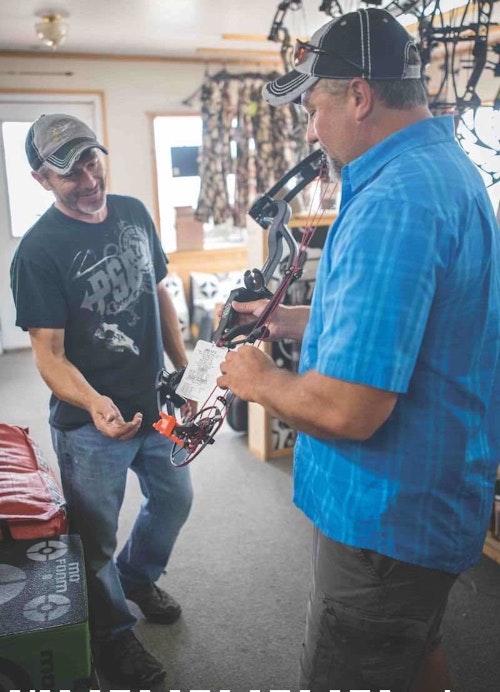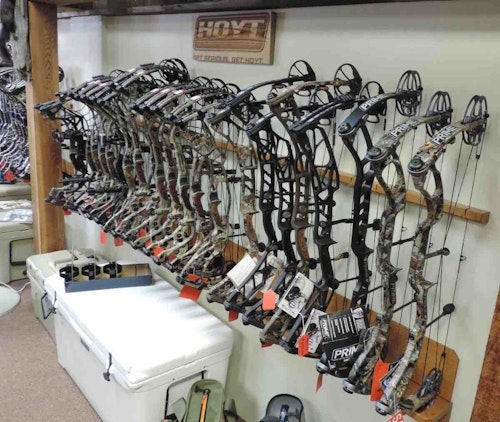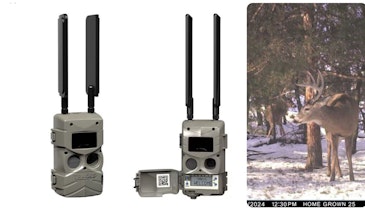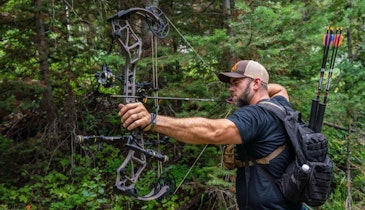When crossbows became legal hunting tools for any hunter during Wisconsin’s archery deer season, the movement completely changed bow sales for archery dealers. No, compound sales didn’t shut down. But crossbow sales certainly stole a portion of the thunder.
Minnesota, however, restricts crossbow hunting during archery deer season to handicapped hunters by permit, and folks who are 60 years or older. These two contrasting states are great examples of why it is so important for archery dealers to stock the right mix of compounds and crossbows. But what is the “right” mix?
Of course, every retailer faces the challenging decision of how many compounds and crossbows to bring in each year. If you’re looking for the magic number, you won’t find it here. You will find, however, some valuable input from two experienced dealers. I recently discussed the topic with Dan Bloch of Archery Country in Rogers, Minnesota, and also Justin Steinke of Butch’s Archery in Clintonville, Wisconsin. Following are some highlights from our discussions.
First Things First
As mentioned before, states have different legislation governing crossbow hunting. Still, crossbows are legal at some capacity in every state, except for Oregon, where they’re considered illegal hunting equipment. So, if you’re not located in Oregon, you can expect to annually sell crossbows in your store. The question is, how many?
Obviously, sales of compounds and crossbows can be somewhat comparable in states where crossbows are legal for any licensed hunter to use during archery seasons. That won’t be the case in states such as Alaska or Washington where crossbows are legal to hunt with only during firearms seasons. Basically, you must know your state’s regulations in order to make an educated guess at a percentage of compounds versus crossbows you can expect to sell. Then, you almost have to study buying trends for a year or two to truly know what your customers will be buying.

Some Trends
After many years in archery retail, Steinke knows bow and crossbow sales inside and out. He’s identified some trends in Wisconsin that help him stock the right mix of compounds and crossbows relative to the times when each sells most.
“Looking at overall sales numbers,” Steinke said, “the trend continues to be about 50/50 as for percentages of compounds and crossbows. The biggest difference between the two is when they sell best. We sell very few crossbows early in the year. In contrast, we sell lots of compounds from the beginning of the year clear into September when archery season opens. We don’t need a pile of crossbows on the shelf in the spring because they tend to sell more regularly right before the archery opener through October.
“The reason for that is simple. Compounds require more practice to achieve proficiency, so most customers prefer to get them early and spend time practicing throughout the summer. Crossbows are far simpler to shoot accurately, so it’s often the last-minute folks who are buying crossbows. We must have a great selection of crossbows on hand from August through October in order to keep up with the demand.”
The landscape is a bit different at Archery Country in Minnesota, as Bloch shared during our discussion.
“Generally, we stock about nine compounds for every crossbow,” Bloch said. “As a sales percentage, it varies somewhat. September is when crossbow sales pick up, and they continue selling until November. Earlier in the year, say, spring through early September, compounds sell really strong.”
Regardless of which state you’re in, based on Steinke’s and Bloch’s findings, I’d say it’s a safe bet — regardless of your state — to have a greater stock of crossbows on hand by late August, but to put greater priority on having a generous assortment of new compounds early in the year.

Know Your Customers and Popular Price Ranges
As you study trends for a year or two, pay close attention to who is buying what. Steinke weighed in.
“I see a little bit of everything,” he said. “I’d say about 40 percent of crossbow buyers are folks who previously hunted only with rifles and now have purchased crossbows in order to lengthen their seasons. Some might have bowhunted when they were young and now find crossbows a viable way to jump back into ‘archery’ hunting. It’s pretty obvious that crossbows have increased hunting participation, as I commonly see more vehicles than ever in parking lots of public hunting areas.”
With compounds, it goes without saying that you’ll have young, middle-aged and old customers because the compound bow is still a time-honored tool both for recreation and hunting. Some will be newcomers to archery and hunting, while others will be longtime archers and bowhunters. Expect a mix of intermediate customers, too.
As important as bringing in the right mix of compounds and crossbows is knowing which price ranges are most popular. In other words, you don’t want dozens of cheap crossbows on the shelf if most customers go for an all-inclusive $1,200 package. Every shop might have different trends in this regard, and again, you’ll acquire this insight after a few seasons.
“Lately, I’ve been seeing that $1,300 and above is the hot ticket with crossbows,” Steinke said. “I believe it’s related to the customer’s seriousness and involvement. If they’re getting trail camera pictures of big deer, many want to increase their effectiveness with a high-end crossbow. They want to feel more confident if they get an opportunity to harvest a big buck. The less-prepared last-minute customers generally buy crossbows as a convenience thing, and they’re usually $400-$700 customers. And then the $800-$1,200 customer is usually new to crossbow hunting and isn’t jumping straight into high-end, but doesn’t want to settle for low-end, either.”
Bloch also shared that crossbow packages right around $1,200-$1,400 seem to be the ticket lately. And as for compounds, Steinke and Bloch noted some trends they’re noticing.
“2021 was a really strong year for high-end compound bows,” Steinke said. “The mid-priced stuff really didn’t sell at all in 2021. In the past, that $500-$800 price range was usually bought most by semi-casual bowhunters. I believe those customers have now transitioned to crossbows, and that would explain why the mid-priced bows stopped selling. As usual, super-adjustable low-end package bows sold well, too, often to beginners and especially youths.”
Block agreed to some extent. “After people saw how the pandemic played out,” he said, “high-end compound sales have skyrocketed. We sell a lot of $1,000-$1,200 bows. Despite that, we still sell plenty of $600-$700 bows, too. And the very adjustable $300-$500 bows always do well, particularly with youth customers. But, the high-end bows are the strong sellers right now.”

Ordering Safe Percentages
If you’re new to archery retail or perhaps haven’t found the sweet spot, the best way to order a safe percentage of compounds and crossbows is to know whether your customers are primarily hunters or if you have numerous target and competitive archers, too. Target archery can turn the table in favor of compounds.
“My customers are primarily hunters,” Steinke said. “That’s why a 50/50 percentage is ideal for a shop like mine in a state like Wisconsin that allows anyone to hunt with a crossbow during archery season. If you have a lot of target and recreational archers, you might consider adjusting the percentage to maybe 60 percent compounds to 40 percent crossbows.”
Bottom Line
Crossbows are considered legal weapons at some capacity in 49 states. That means they’re here to stay, and they’ll certainly steal some fire from compound bow sales.
While this article didn’t exactly provide you with a magic number of compounds and crossbows that you should bring in, the input from Bloch and Steinke should help you navigate the waters and put together a bow and crossbow rack that offers every type of archer and hunter something.
Sidebar: The Toss-Up Customer
It’s practically a given that most bow shops will have a customer come in who has no preference toward crossbows or compounds. Do you sway them toward buying a compound bow or a crossbow? Good question.
“I don’t try to persuade customers one way or the other,” said Justin Steinke of Butch’s Archery in Clintonville, Wisconsin. “Instead, I present them with the facts. I specifically like to discuss with them their intended uses. I personally don’t consider crossbows a recreational item; I consider them hunting tools. So, I try to determine if the individual would rather purchase a compound, which is more practical for recreational archery — shooting with family or buddies — but can also make a deadly hunting tool. If so, I suggest a compound. On the other hand, if the individual is a casual hunter who gets out hunting a few weekends in the fall, a crossbow is probably a better option.”

Sidebar: How Many Lines Should You Carry?
It’s always a question: How many bow and crossbow lines should you carry? Are you missing sales by having too few lines? Are you complicating decisions for your customers by having too many?
Well, one point for consideration if you’re located close to competitors is you’ll be limited with premium brands you can bring in if the companies have protection parameters to prevent dealers in close proximity from competing over the same brands. Beyond that, Bloch shared his thoughts based on his retail experience in Minnesota.
“For crossbows, Ravin is clearly our top seller,” said Dan Bloch of Archery Country in Rogers, Minnesota. “Excalibur, TenPoint and Wicked Ridge are next in line, followed by Mission and Killer Instinct. We have these on hand, plus, we can order practically anything.
“As for compounds, we have basically everything there, too. Our top offerings are PSE, Bear, Hoyt, Prime, Elite, Bowtech and Mathews, and we keep bows from those lines on hand. It seems like a lot of options, but offering everything has made our store a destination. In addition to Minnesota, we commonly serve customers from Iowa, North Dakota, South Dakota and Wisconsin because of our big selection. It’s been a huge benefit.”






